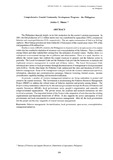| dc.contributor.author | Munoz, Jessica C. | |
| dc.date.accessioned | 2019-06-14T02:44:13Z | |
| dc.date.available | 2019-06-14T02:44:13Z | |
| dc.date.issued | 2003 | |
| dc.identifier.citation | Munoz, J. C. (2003). Comprehensive coastal community development program: the Philippines. In Proceedings of the Toward Further Development of Coastal Resource Management: Lessons gained through Locally Based Coastal Resource Management in Pathew District, Chumporn Province, Thailand (pp. 199-203). Samut Prakan, Thailand: Training Department, Southeast Asian Fisheries Development Center. | en |
| dc.identifier.isbn | 9749509439 | |
| dc.identifier.uri | http://hdl.handle.net/20.500.12067/908 | |
| dc.description.abstract | The Philippines depends largely on its fish production for the country s protein requirement. In 2001, the fish production of 3.2 million metric tons was contributed by aquaculture (38%), commercial fisheries and municipal fisheries (31%, respectively). The per capita consumption of fish is at 26.8 kg/ capita/yr. Most fishing activities are done within the 15 kilometers of the coastal areas where 70% of the total population of 80 million lives.
Similar to some ASEAN countries, the Philippines is characterized by an open access of its marine waters that has resulted to depletion of resources and overexploitation of the fisheries. There is conflict among fishers and other stakeholders arising from the utilization of coastal waters. Further, there is a widespread environmental damage due to pollution and deforestation. There is a need, therefore, to address the various issues that confront the coastal resources in general, and the fisheries sector in particular. The Local Government Code and the Fisheries Code provide the framework to institute and implement resource management in coastal and offshore waters. The Local Government Code introduced new norms in local governance through decentralization of management to local government units (LGUs). On the other hand, the Fisheries Code underscored the roles and functions of LGUs in fisheries management. Some of the management strategies include the resource enhancement activities; information, education and communication campaign; fisheries licensing; limited access; income diversification; capability building; and income diversification.
At present, a number of resource management initiatives are being undertaken to protect and conserve the coastal resources. The Government is implementing the Fisheries Resource Management Project (FRMP) to address the critical issues of fisheries depletion and poverty among fishers. The Project is being undertaken collectively by the national government through the Bureau of Fisheries and Aquatic Resources (BFAR), local government units, people s organization and councils; and nongovernmental organizations. The private sector, the academe and research institutions are also involved as partners. The important feature of the Project is the integration of activities into the existing organizational and functional framework of BFAR. It also supports the active participation of local governments and local communities in coastal resource management. After all, the local governments and the people are the true vanguards of coastal resource management. | en |
| dc.language.iso | en | en |
| dc.publisher | Training Department, Southeast Asian Fisheries Development Center | en |
| dc.title | Comprehensive Coastal Community Development Program: the Philippines | en |
| dc.type | Conference paper | en |
| dc.citation.spage | 199 | |
| dc.citation.epage | 203 | |
| dc.citation.conferenceTitle | Proceedings of the Toward Further Development of Coastal Resource Management: Lessons gained through Locally Based Coastal Resource Management in Pathew District, Chumporn Province, Thailand | en |

